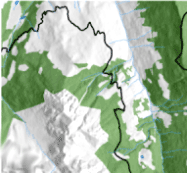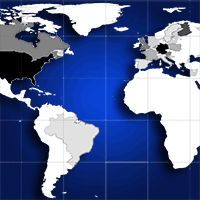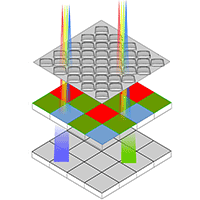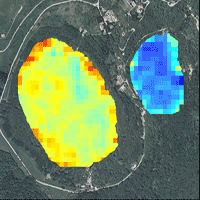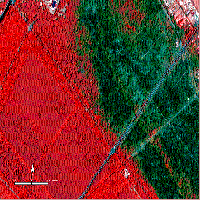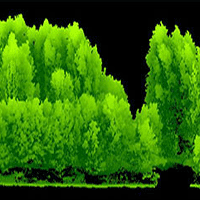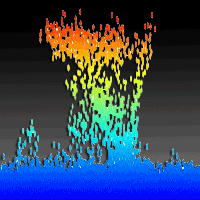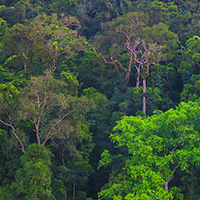
A primary evaluation of Syrian forest damage since 2011: a case study of Alhamam and Alboz forest sites
Manaf Aldakhil (1-2-3), Shaher Abdullateef (1-3), Fares Mahmoud (1-4-5), Amin Alhasan (1-6), Abdulkarim Lakmes (1-7), Melhem Al Abdullah (1), Gary R Watmough (8)
iForest - Biogeosciences and Forestry, Volume 16, Issue 3, Pages 144-154 (2023)
doi: https://doi.org/10.3832/ifor4032-016
Published: May 30, 2023 - Copyright © 2023 SISEF
Research Articles
Abstract
Forests and trees make vital contributions to well-being, economic activities, ecosystem functioning and global system dynamics. There has been a lack of studies on the evaluation of the drivers of Syrian forest damage during the current conflict. This study estimated the damage since 2011 in the Alhamam and Alboz forest sites in Idlib province of Syria and evaluated the drivers of this damage. A multidimensional approach to damage assessment was developed which combined forest plot inventories, remotely sensed satellite image analysis, questionnaires and focus groups to enable a comparison of the forest from 2011 and 2017. The plot inventory data and remote sensing analysis provided estimates of forest damage and loss whilst focus groups and questionnaires provided vital information on the drivers of forest loss which is required for developing reforestation programmes. Overall, forest inventory data and satellite image analysis results indicated a reduction in tree cover, density and plant diversity. The results indicate a much higher loss of forest than is available from global products such as Global Forest Watch due to the prevalence in Syria of low-density Oak forests such as Alhamam not being classed as forest. The results of questionnaires and focus groups showed that the main cause of damage was an increased demand for fire-wood driven by a lack of fuel oil and increased unemployment, reduced household incomes and general price rises, making fuel more unaffordable. Respondents to surveys generally understood the importance of trees and forests and overtime the local knowledge of the importance of forest resources had not changed. This multidimensional approach indicates a reduced capacity of institutions to protect forests and will help to establish strategic plans to serve and protect the forest in the future.
Keywords
Authors’ Info
Authors’ address
Free Aleppo University, Aleppo (Syria)
Shaher Abdullateef 0000-0002-0024-9151
Academic Center for Development and Peace Studies
University of Lausanne, Lausanne (Switzerland)
University of Geneva, Geneva (Switzerland)
Idleb University, Idleb (Syria)
School of Geosciences, University of Edinburgh, Edinburgh, Scotland (UK)
Corresponding author
Paper Info
Citation
Aldakhil M, Abdullateef S, Mahmoud F, Alhasan A, Lakmes A, Al Abdullah M, Watmough GR (2023). A primary evaluation of Syrian forest damage since 2011: a case study of Alhamam and Alboz forest sites. iForest 16: 144-154. - doi: 10.3832/ifor4032-016
Academic Editor
Paola Mairota
Paper history
Received: Dec 02, 2021
Accepted: Feb 28, 2023
First online: May 30, 2023
Publication Date: Jun 30, 2023
Publication Time: 3.03 months
Copyright Information
© SISEF - The Italian Society of Silviculture and Forest Ecology 2023
Open Access
This article is distributed under the terms of the Creative Commons Attribution-Non Commercial 4.0 International (https://creativecommons.org/licenses/by-nc/4.0/), which permits unrestricted use, distribution, and reproduction in any medium, provided you give appropriate credit to the original author(s) and the source, provide a link to the Creative Commons license, and indicate if changes were made.
Web Metrics
Breakdown by View Type
Article Usage
Total Article Views: 26407
(from publication date up to now)
Breakdown by View Type
HTML Page Views: 21739
Abstract Page Views: 2528
PDF Downloads: 1781
Citation/Reference Downloads: 3
XML Downloads: 356
Web Metrics
Days since publication: 951
Overall contacts: 26407
Avg. contacts per week: 194.37
Citation Metrics
Article Citations
Article citations are based on data periodically collected from the Clarivate Web of Science web site
(last update: Mar 2025)
Total number of cites (since 2023): 1
Average cites per year: 0.33
Publication Metrics
by Dimensions ©
Articles citing this article
List of the papers citing this article based on CrossRef Cited-by.
References
A study of the biodiversity and the ecological, phytosociological and demographical analyses of Al-Qaseer Height in Northwest Syria (Idleb province). Renewable Natural Resources and Ecology Department - RNRED, Faculty of Agriculture, Aleppo University, Syria, pp. 382.
Gscholar
Biogéographie évolutive [Evolutionary biogeography]. Edition Masson, Paris, France, pp. 221. [in French]
Gscholar
Géographie botanique: étude de la vegetation [Botanical geography: study of vegetation]. Presses Universitaires de France, Paris, France, vol. 313, pp. 126. [in French]
Gscholar
Analyse phytosociologique, phytoecologique, dendrometrique et dendroclimatologique des forets de Quercus cerris L. subsp. pseudocerris et contribution a l’étude taxinomique du genre Quercus L. en Syrie [Phytosociological, phytoecological, dendrometric and dendroclimatological analysis of the forests of Quercus cerris L. subsp. pseudocerris and contribution to the taxonomic study of the genus Quercus L. in Syria]. Doctoral thesis in science, Faculty of Science of st. Jérame, University of Aix-Marseille, France, pp. 342+176.
Online | Gscholar
Sol et climax forestiers en Syrie littorale [Forest soil and climax in coastal Syria]. Ecologia Mediterranea 8 (1-2): 137-141. [in French]
Gscholar
Deforestation in Colombian protected areas increased during post-conflict periods. Scientific Reports 10: 4971.
CrossRef | Gscholar
Integration of GLAS and Landsat TM data for aboveground biomass estimation. Canadian Journal of Remote Sensing 36 (2): 129-141.
Gscholar
Capacity building in sustainable forest management planning and forest fire management in Syria. Ministry of Environment and Forestry, Syria, General Directorate of Forestry Forest Management and Planning Department, Turkey, and FAO, Province Directorate of Agriculture and Agrarian Reform, Idleb, Syria, pp. 666.
Gscholar
Focus group discussions: understanding qualitative research. Oxford University Press, Oxford, UK, pp. 230.
Gscholar
Eléments de biogéographie [Elements of biogeography]. Fernand Nathan, Paris, France, pp. 189. [in French]
Gscholar
Remote sensing and image interpretation (7th edn). John Wiley and Sons, Inc., New York, USA, pp. 736.
Gscholar
A study of the frequency of dust storms and the factors of there appearance in the Syrian Badia. Damascus University Journal of Agricultural Sciences, vol. 15, Damascus, Syria.
Gscholar
Research methods in social relations (8th edn). Wiley-Blackwell, London, UK, pp. 576.
Gscholar
Post-fire management and restoration of Southern European forests. In: “Post-Fire Management and Restoration of Southern European Forests” (Moreira F, Arianoutsou M, Corona P, De las Heras J eds). Managing Forest Ecosystems, vol. 24, Springer Science and Business Media, Dordrecht, Netherlands, pp. 330.
Online | Gscholar
The Mediterranean climate from a biological viewpoint. In: “Mediterranean-type shrublands” (Di Castri Goodall W, Specht RL eds). Ecosystem of the World, vol. 11, Elsevier, Amsterdam-Oxford-London, pp. 63-86.
Gscholar

